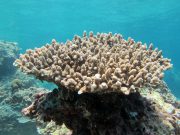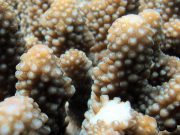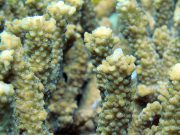Dykning med Staghorn-koraller
Koh Lantas Marineliv | Acroporidae
Familien Acroporidae, kendt som 'staghorn'- eller 'grenkoraller', er en familie af hårde koraller, der danner kolonier med forgrenede strukturer, ligesom et træ, et bord eller en busk, hvor grenene eller de fingerlignende vækster er dækket af tusindvis af koralpolypper.
Man ser mange arter af staghornkoraller, når man dykker fra Koh Lanta.
Disse hurtigtvoksende koralgrene er normalt omgivet af små koralpolypper, der kaldes radiale koralitter, og de toppes af en karakteristisk aksial polyp, der normalt er større end de radiale polypper.
Acropora-koraller findes i mange former og størrelser og kan variere meget i farve og form, selv inden for den samme art.



Der kan dannes enorme kolonier, og mange arter er meget vigtige revbyggere. Farver og kolonidannelse kan afhænge af korallens vækstbetingelser, dybde, vandets klarhed, strømforhold og så videre.
Kolonierne kan være forgrenede, bordformede eller i nogle tilfælde skorpedannende og findes på alle dykkersteder omkring Koh Lanta.
Det er svært at identificere koraller, og det kræver enten en nøje undersøgelse af korallitterne eller i ekstreme tilfælde en biokemisk og genetisk analyse.
Nye kolonier dannes, når grene brækker af og sætter sig fast på underlaget igen, kendt som ukønnet formering. Seksuel reproduktion (gydning) for Acropora-koraller sker en eller to gange om året ved fuldmåne, og gydningsmånederne varierer afhængigt af art og sted.
Du kan finde flere oplysninger her http://www.coralsoftheworld.org/page/home/
6 arter fundet på denne side:
- Acropora Austera Branching Coral (Acropora austera)
- Acropora Granulosa Table Coral (Acropora granulosa)
- Acropora Hyacinthus Table Coral (Acropora hyacinthus)
- Acropora Humilis Branching Coral (Acropora humilis)
- Acropora Secale Branching Coral (Acropora secale)
- Acropora Korusini Table Coral (Acropora korusini)
Acropora Austera Branching Coral
(Acropora austera)
This species forms colonies of very different shapes, from arborescent (tree-like) to very dense bushes/thickets. Branches vary in length, can be long, disorderly and partially fused. Sub branches are short, tapered and very abundant.

Acropora austera @ Koh Haa
The axial corallites are short, thick tubes with small openings. Radial corallites are sometimes arranged in rows, very close to each other, of different sizes and have thick walls with oblique, round or square openings.
Radial corallites vary from immersed to appressed, making the branches appear ragged.

Acropora austera @ Koh Haa
Acropora Granulosa Table Coral
(Acropora granulosa)
This table-like species in generally uncommon and grows in semi-circular horizontal plates, usually less than 1 m in diameter. The main branches are usually straight and horizontal, with the short secondary branches curving upward and equidistant to each other.

Acropora granulosa @ Hin Bida
Each secondary branch or branchlet is formed by a group of axial corallites and developing axial corallites, or only a single, large axial corallite which is long, think and swollen with a relatively small opening.
The axial corallite tip may be tapered or blunt. The radial corallites are tubular, small and appressed (their wall is directly attached to the branch from which they grow)

Acropora granulosa @ Hin Bida
Acropora Hyacinthus Table Coral
(Acropora hyacinthus)
This species forms wide flat table-shaped colonies and tiered aggregations of small plates with short branches that curve upwards in an orderly way. The central branches are usually fused.

Acropora hyacinthus @ Koh Haa
The axial corallites are tubular, rounded and slightly prominent. The radial corallites form rosettes, with the coralite wall attached to the branch from which it grows. Radial coralites are next to each other, and of the same size.
Acropora Humilis Branching Coral
(Acropora humilis)
This species forms digitate colonies with a broad, encrusting base Branches are thick, finger-like, gradually tapering to large dome-shaped axial corallites. This coral species can be cream, green, purple or blue.

Acropora humilis @ Koh Bida
The radial corallites are of two sizes, the larger are usually tubular, with thick walls and have oblique to nariform openings.
The smaller radial corallites are tubular apressed with a less developed outer wall and nariform opening.

Acropora humilis @ Koh Bida
Acropora Secale Branching Coral
(Acropora secale)
This species forms corymbose bushy colonies with thick tapered branches which are finger-like. Colonies are colourful, usually mixtures of cream, blue, purple, brown and yellow, commonly with purple branch ends and cream corallites.

Acropora secale @ Koh Bida
The axial corallites are tubular, small and have a relatively wide edge. The radial corallites are of mixed sizes, some are long tubes with round opening, others appressed (part of their wall is attached to the branch from which they stem).
The radial corallites are large and conspicuous, and some are quite long. Branches can look ragged or rough.

Acropora secale @ Koh Bida
Acropora Korusini Table Coral
(Acropora korusini)
This species forms corymbose colonies that can form a table-like structure with vertical branches. Branches along the outer edges are more horizontal than those in the center. The colony has a generally disorderly layout.

Acropora korusini @ Koh Bida
The axial corallites are tubular or slightly cone shaped, small and prominent. The radial corallites are lip-like/nariform with a swollen outer wall.
Some radial corallites may be slightly hooked and some may face in different directions. Radial corallites are next to each other and may be a mix of both large and small sizes.

Acropora korusini @ Koh Bida
Dykning med Staghorn-koraller omkring Koh Lanta
Dykning og snorkelture
Hvis du gerne vil have chancen for at se Staghorn-koraller på en af vores daglige dykkerture i højsæsonen fra Koh Lanta, så send os en e-mail til info@diveandrelax.com.
Deltag i vores speedbådsdykkerture i højsæsonen til nogle af Thailands bedste dykkersteder og nyd små grupper, korte rejsetider med fokus på god personlig service, sikkerhed og sjov.
Er du endnu ikke certificeret dykker? Lær at dykke på Koh Lanta med det 3-dages SSI Open Water Diver-kursus.
Book online og spar 10% på dykkerture og dykkerkurser på Koh Lanta.
Få mere at vide
Indo-Stillehavets havdyrsguider
- Allen, G., Steene, R., Humann, P., DeLoach, N. (2003) Reef Fish Identification, Tropical Pacific. Jacksonville, FL., USA: New World Publications, Inc., ISBN 1-878348-36-1.
- Humann, P., DeLoach, N., (2010) Reef Creature Identification, Tropical Pacific. Jacksonville, FL., USA: New World Publications Inc., ISBN 978-1-878348-44-9
- Debelius, H. (2013) Indian Ocean Reef Guide. Frankfurt, Germany: IKAN - Unterwasserarchiv, ISBN 978-3-939767-52-7.
- Debelius, H. (2004) Nudibranchs and Sea Snails, Indo-Pacific Field Guide. Frankfurt, Germany: IKAN - Unterwasserarchiv, ISBN 3-925919-51-1
- Erhardt, H., Knop, D. (2015) Corals Indo-Pacific Field Guide. Frankfurt, Germany: IKAN - Unterwasserarchiv, ISBN 3-925919-69-4.
- Veron J.E.N., Stafford-Smith M.G., Turak E. and DeVantier L.M. (2016). Corals of the World
Flere referencer om havets dyreliv og yderligere information





